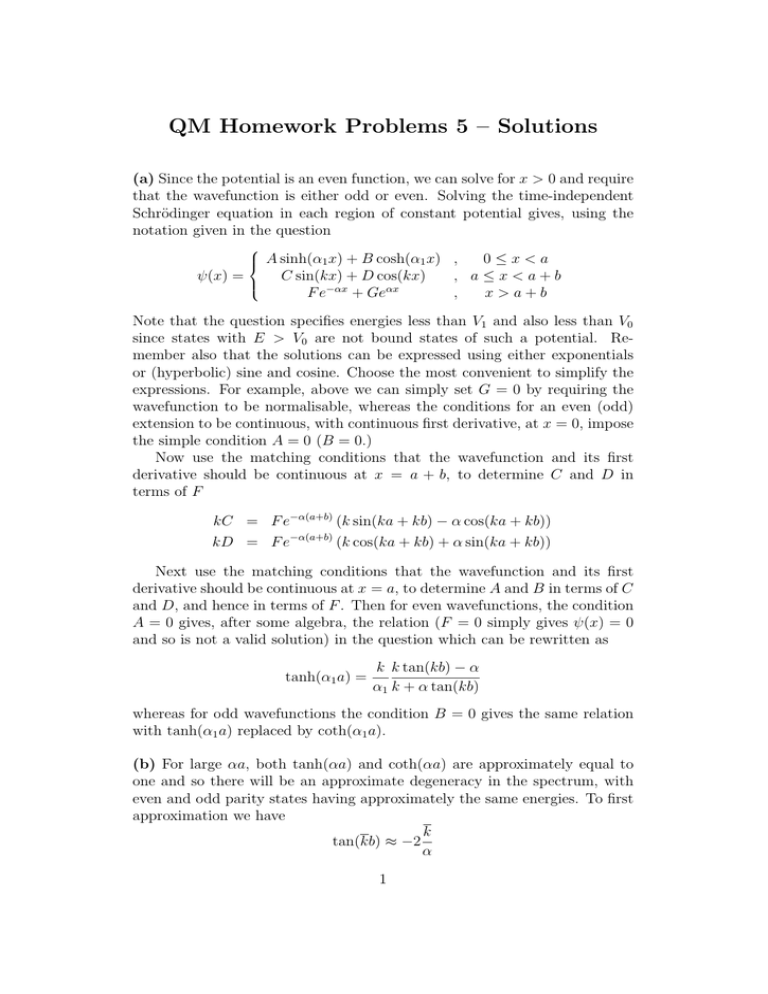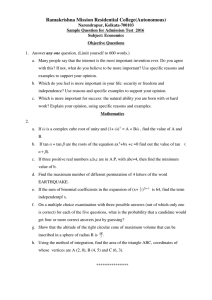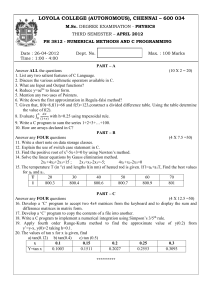QM Homework Problems 5 – Solutions
advertisement

QM Homework Problems 5 – Solutions (a) Since the potential is an even function, we can solve for x > 0 and require that the wavefunction is either odd or even. Solving the time-independent Schrödinger equation in each region of constant potential gives, using the notation given in the question A sinh(α1 x) + B cosh(α1 x) , 0≤x<a , a≤x<a+b ψ(x) = C sin(kx) + D cos(kx) F e−αx + Geαx , x>a+b Note that the question specifies energies less than V1 and also less than V0 since states with E > V0 are not bound states of such a potential. Remember also that the solutions can be expressed using either exponentials or (hyperbolic) sine and cosine. Choose the most convenient to simplify the expressions. For example, above we can simply set G = 0 by requiring the wavefunction to be normalisable, whereas the conditions for an even (odd) extension to be continuous, with continuous first derivative, at x = 0, impose the simple condition A = 0 (B = 0.) Now use the matching conditions that the wavefunction and its first derivative should be continuous at x = a + b, to determine C and D in terms of F kC = F e−α(a+b) (k sin(ka + kb) − α cos(ka + kb)) kD = F e−α(a+b) (k cos(ka + kb) + α sin(ka + kb)) Next use the matching conditions that the wavefunction and its first derivative should be continuous at x = a, to determine A and B in terms of C and D, and hence in terms of F . Then for even wavefunctions, the condition A = 0 gives, after some algebra, the relation (F = 0 simply gives ψ(x) = 0 and so is not a valid solution) in the question which can be rewritten as tanh(α1 a) = k k tan(kb) − α α1 k + α tan(kb) whereas for odd wavefunctions the condition B = 0 gives the same relation with tanh(α1 a) replaced by coth(α1 a). (b) For large αa, both tanh(αa) and coth(αa) are approximately equal to one and so there will be an approximate degeneracy in the spectrum, with even and odd parity states having approximately the same energies. To first approximation we have k tan(kb) ≈ −2 α 1 and so k k tan(kb) − α k −α =1 ≈ α k + α tan(kb) α k − 2k as required. Now we want to consider the corrections to this result by keeping the leading order terms in the expansions in small k/α and δk/k, and large αa where k = k + δk is an exact solution. So we have eαa − e−αa −2αa −2αa −1 = 1 − e 1 + e eαa + e−αa ≈ 1 − e−2αa 1 − e−2αa ≈ 1 − 2e−2αa tanh(αa) = while similarly coth(αa) ≈ 1 + 2e−2αa We also need to expand tan(kb) = tan(kb) + tan(δkb) 1 − tan(kb) tan(δkb) using tan(kb) ≈ −2 k α and tan(δkb) ≈ δkb This last approximation is required for the approach to be self-consistent since if δkb is not much smaller than one, the differences to the spectrum will be at least comparable to the separation in energies of the different discrete energies for the single well potential (recall in that case that the solutions are approximately kb being a multiple of π.) It is clear in the final answer that this approximation is consistent. So expanding to first order in the small parameters δkb and αk we have tan(kb) ≈ −2 k + δkb α We can now easily see that the leading order terms in the expression for tanh(αa) and coth(αa) are given by the numerator ! k k k tan(kb) − 1 ≈ −2 + δkb − 1 ≈ −1 α α α 2 since we are neglecting all terms of quadratic or higher order in the small quantities. Similarly for the denominator we have α αδk α − 2 1 + tan(kb) ≈ 1 + k k k ! ! δk k −2 + δkb ≈ −1 + (αb + 2) α k Hence, taking the ratio we have 1 ∓ 2e−2αa ≈ 1 + δk (αb + 2) k which immediately gives the required result 2ke−2αa δk ≈ ∓ αb + 2 where the minus sign is appropriate for the even parity wavefunctions, while the plus sign is for the odd parity wavefunctions. We can easily convert this into an expression for the shift in energies, δE, from the energies, E, for a single well δE 4e−2αa ≈∓ αb + 2 E which clearly shows that the spectrum for the double well potential is almost two identical copies of the spectrum for the single well potential, with the energies of one copy (even parity) a small fraction lower and those of the other copy (odd parity) higher by the same small fraction. Comments: In the above manipulations we ignored the variation of α. This was justified because for fixed V0 we have δα ≈ α k α !2 δk k and so such terms will be very small. I.e. simply replacing α with its value α for the single well case will only lead to negligible corrections to the coefficient of δk . k We were also not very precise about which terms could be ignored. The precise prescription is to ignore terms which are definitely smaller than other terms appearing in the same expression, except that we have to be careful that some terms may cancel at some point and so we should keep the lowest order terms which appear in the final expression. Since the coefficient of δk is k αb + 2 which is at least 2, it is very easy to see that any other terms involving δk would be much smaller. However, the terms which did not involve δk are k k 3 more subtle. We kept only 2e−2αa . Clearly all other terms in the expansion of tanh(αa) or coth(αa) are much smaller than this. However, you may wonder about the leading order term which involves some power of αk since at no time did we specify how this compares in magnitude to e−2αa . The point here is that in fact there are no such terms since (modulo insignificant corrections to the coefficient of δk as explained above) αk is given in terms of the single k well potential which does not involve the double well separation a. Hence if we consider a result such as δk (αb + 2) ≈ ∓2e−2αa + f k k α ! then since we know that in thelimit a → ∞ (with other quantities fixed) k that δk → 0, we can see that f α = 0. Therefore there are no such terms which we should have included in our result. 4




